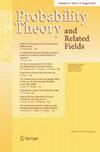On the lack of Gaussian tail for rough line integrals along fractional Brownian paths
IF 1.6
1区 数学
Q2 STATISTICS & PROBABILITY
引用次数: 1
Abstract
Abstract We show that the tail probability of the rough line integral $$\int _{0}^{1}\phi (X_{t})dY_{t}$$分数阶布朗路径粗糙线积分的高斯尾缺失问题
摘要我们证明了粗线积分$$\int _{0}^{1}\phi (X_{t})dY_{t}$$∫0 1 φ (X t) d Y t的尾部概率,其中(X, Y)是一个具有Hurst参数$$H\in (1/4,1/2)$$ H∈(1 / 4,1 / 2)的二维分数阶布朗运动,$$\phi $$ φ是一个满足其导数的温和非简并条件的$$C_{b}^{\infty }$$ C b∞函数,不能比具有任意指数$$\gamma >2H+1$$ γ &gt的$$\gamma $$ γ -威布尔尾部衰减得更快;2h + 1。特别是,这产生了一类由fBM驱动的微分方程的简单例子,即使假设底层向量场为$$C_{b}^{\infty }$$ C b∞类,其解也不具有高斯尾。这也证明了由Cass-Litterer-Lyons在2013年证明的众所周知的上尾估计本质上是尖锐的。
本文章由计算机程序翻译,如有差异,请以英文原文为准。
求助全文
约1分钟内获得全文
求助全文
来源期刊

Probability Theory and Related Fields
数学-统计学与概率论
CiteScore
3.70
自引率
5.00%
发文量
71
审稿时长
6-12 weeks
期刊介绍:
Probability Theory and Related Fields publishes research papers in modern probability theory and its various fields of application. Thus, subjects of interest include: mathematical statistical physics, mathematical statistics, mathematical biology, theoretical computer science, and applications of probability theory to other areas of mathematics such as combinatorics, analysis, ergodic theory and geometry. Survey papers on emerging areas of importance may be considered for publication. The main languages of publication are English, French and German.
 求助内容:
求助内容: 应助结果提醒方式:
应助结果提醒方式:


